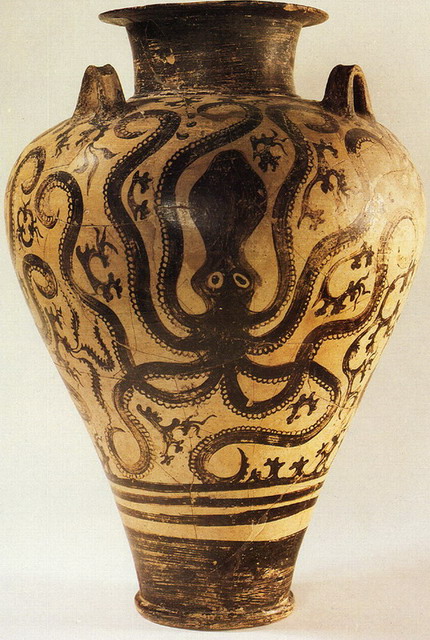 |
|
The North Portico of Knossos, Crete, Greece
|
Ancient Greece is one of my personal favourite periods of
history. The culture of ancient Greece has influenced our own in many ways, yet
still remains alien to us. Most people when they think of the ancient Greeks
they think of individuals like Alexander the Great, cities like Athens and
Sparta and mythical heroes like Hercules and Odysseus. But they are only a
small part of ancient Greece which was a wonderful mishmash of warring city
states and wildly different cultures united, but only rarely, by an
overwhelming sense of Greekness. Therefore, for my first post I am going to
look at one of the less well known periods of Greek history, the Minoan Era.
 | |||
| Ritual Bull's Head |
| The younger snake goddess |
 |
| The fresco of the saffron pickers |
 |
| Minoan terracotta male statuette |
 |
|
The Prince of lilies
|
For
both men and women, a small waist proved to be desirable, and metal belts were
used to try to achieve this. Jewellery too was
worn by both men and women, which included rings, bracelets, necklaces and hair
ornaments. Shoes were rarely worn, but if
necessary both men and women would wear a variety of boots and sandals.
 |
| Octopus vase |
 |
| Reproduction of the "Ladies in Blue" fresco |
Overall,
the Minoan look is possible to recreate. The layered skirt can easily be
recreated or an existing skirt adapted, however, hoops or petticoats would most
likely be required to get the desired shape. But personally, the Minoan fashion
is not one I wish to emulate. Different social conventions make the bare chest
awkward and indecent in most circles. Also important, Minoan fashions were
designed for the island of Crete which has a much warmer climate that England
where I am currently wrapped in several blankets and wearing gloves inside my
house. To me, the Minoans are fascinating purely because we know so little
about them. Their civilisation appears to have been so different to ours.
Indeed, women appear so often and in such prominent positions in their art that
some believe the Minoans might actually have been a matriarchal culture. Yet
there are some similarities, with Minoan fashion being quite similar to that of
France in the 18th century, perhaps proving the idea that humans
remain very similar creatures, even after all this time.
Eleanor
 |
| Minoan Fresco |
For more information please refer to the following:
Fashionencyclopedia.com, (n.d.). Minoan
Dress - Fashion, Costume, and Culture: Clothing, Headwear, Body Decorations,
and Footwear through the Ages. [online] Available at: http://www.fashionencyclopedia.com/fashion_costume_culture/The-Ancient-World-Greece/Minoan-Dress.html
[Accessed 14 Jan. 2016].
Symons, D. (1987). Costume of
Ancient Greece. London: Batsford.
TimeMaps Atlas of World History,
(2016). TimeMaps. [online] Available at:
http://www.timemaps.com/civilization/Minoan-civilization [Accessed 14 Jan.
2016].
Pictures:
https://upload.wikimedia.org/wikipedia/commons/e/ea/Knossos_-_North_Portico_02.jpg
http://www.crete-alacarte.com/en/about_crete/mythology.aspx
https://upload.wikimedia.org/wikipedia/commons/f/f5/%CE%98%CE%B5%CE%AC_%CF%84%CF%89%CE%BD_%CE%8C%CF%86%CE%B5%CF%89%CE%BD_6393.JPG
http://www.amazon.co.uk/Minoan-fresco-tile-saffron-gatherer-3/dp/B005602W0A
https://upload.wikimedia.org/wikipedia/commons/6/67/Feather_prince.jpg
http://www.cfa.ilstu.edu/lmlowel/THE331/AegeansGreeks/Aegeanreview.html
http://www.metmuseum.org/collection/the-collection-online/search/258137
https://ferrebeekeeper.files.wordpress.com/2011/04/minoan-jar.jpg
https://www.psychologytoday.com/blog/out-the-darkness/201410/if-women-ruled-the-world-0
No comments:
Post a Comment